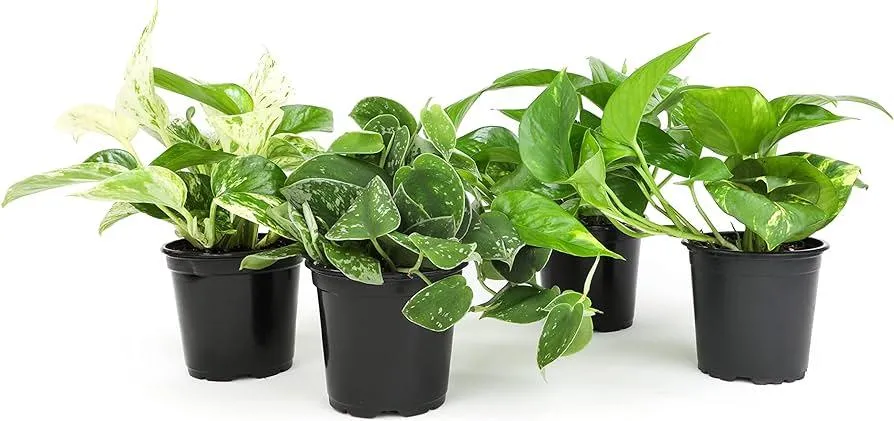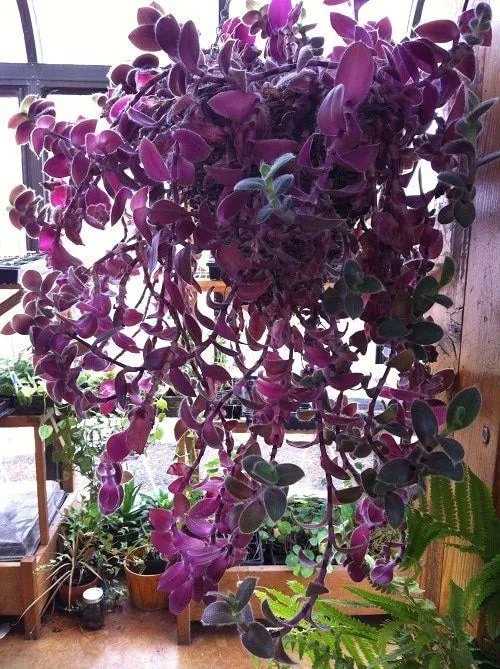The Best Purple Hanging Houseplants to Brighten Your Home
If you’re searching for hanging purple house plants, you’ve come to the right place. Purple foliage adds a vibrancy and drama to any indoor space. In this article, I’ll cover the top purple hanging plant options and provide care tips to keep them looking their best. By the end, you’ll know which plant is the perfect match for your home décor and lifestyle.
Purple Wandering Jew (Tradescantia pallida)
The purple wandering jew is one of my personal favorites forbrightening up dull corners. Its stems cascade down in loose coils, covered in small purple oval leaves. It thrives in low to medium light and tolerates neglect fairly well. From my experience, it can get leggy if not trimmed back occasionally. Propagation is a breeze—just break or cut off a stem and replant the nodes in soil. Another great perk is its tolerance of lower light conditions, making it suitable for homes with less-than-ideal light exposure.
Purple Heart (Tradescantia zebrina)
Closely related to the wandering jew, purple heart has stripes of deep purple running through its broad, arrow-shaped leaves. It grows more upright than its trailing cousin. The purple heart prefers brighter filtered light and more consistently moist soil. Neglect it and the leaves will begin to fade and drop. However, it rebounds quickly when given the care it needs. Plus, it makes an impact even in small pots with its bold foliage.
String of Hearts (Ceropegia woodii)
With heart-shaped leaves strung along wiry stems, the string of hearts is simply adorable. It thrives in bright, indirect light and tends to freeze up if overwatered. The trick is to water only when the leaves start to look wrinkled. Allow the soil to dry out mostly between waterings. In time, it will cascade beautifully in long chains. Despite its diminutive size, it makes a lovely decorative accent hanging in a snug corner.
Spider Plant (Chlorophytum comosum)
No list of top hanging plants would be complete without the virtually indestructible spider plant. Its long, arching grass-like leaves emerge in shades of blueish-green to deep violet. Spider plants are among the easiest houseplants to care for. They tolerate low to medium light, infrequent watering, and being pot-bound. Another big plus is their tendency to produce baby plantlets which can be removed and planted to make new spider plants. These small plant clones are basically spider plant factories!

Care Tips for Purple Hanging Plants
While the above plants have varying care needs, here are some general tips that apply to most:
- Hang plants in spots with indirect, bright light but protect from direct sun, which can cause fading or damage.
- Water when the top 1-2 inches of soil is dry. For trailing plants, water only moderately to prevent overwatering.
- Mist foliage regularly to increase humidity around plants and prevent browning leaf edges.
- Fertilize every 4-6 weeks during growing season with a diluted, water soluble houseplant fertilizer.
- Repot in early spring every 1-2 years using a pot one size larger filled with a well-draining potting mix.
- Prune leggy growth or individual leaves as needed to maintain a bushy habit.
- Rotate pots occasionally to encourage even growth.
The key is finding the right balance of light, water, and humidity for each plant’s needs. With some trial and error, you’ll get the hang of caring for these beauties to enjoy their vivid blooms for many months on end.
Choosing the Perfect Pot
An attractive container can elevate your hanging plant from nice accent to true showstopper. When selecting a pot, consider these factors:
- Size: Choose an appropriately sized pot that’s not too big or small for the plant.
- Drainage: Ensure the pot has drainage holes to prevent root rot.
- Material: Terra cotta and glazed ceramic are popular, light options. Avoid unglazed terra cotta in very hot spots.
- Color: Consider how the pot’s color will blend or contrast with your plants’ foliage hues.
- Shape: Round pots tend to show off trailing plants beautifully. More angular pots work well for upright varieties.
Play around with pairings until you find a pot-plant match that takes your breath away. Get creative—add hooks, macramé hangers, or plant stands to customize hanging styles that suit your space.
Dealing with Pests
Unfortunately, critters may potentially munch on your precious purple plants. Here are some common culprits and treatments:

Spider Mites
These tiny pests cause leaf stippling or webbing. Isolate the infested plant and spray leaves with insecticidal soap or neem oil. Repeat weekly until clear. Always wash hands after handling infested plants to avoid spreading mites.
Mealybugs
Fluffy white dots cling near leaf joints and stems. Wipe impacted areas with cotton balls dipped in rubbing alcohol. Or use an insecticidal soap spray.
Scale
Hard, armor-like shells protect these sucking insects. Scrape off with your fingernail under warm running water. Neem oil or insecticidal soaps work too. Keep an eye out for infestations beginning until eradicated.
With proper identification and treatment of pests, your plants can fully recover and thrive once more. The joys of indoor greenery are worth defending against tiny invaders!
In Closing
I hope this guide has given you a clear idea of top hanging purple plant picks to brighten any home or office space. Factor in light, care needs, style, and potential pests whenever selecting houseplants. With a little TLC, their striking foliage will brighten your days for many moons to come. Happy planting!

Recommendations for Hanging Purple House Plants
| Plant | Light Needs | Watering | Size |
|---|---|---|---|
| Wax Begonia | Bright indirect light | Water when top soil is dry | Up to 12 inches |
| Purple Waffle Plant | Bright indirect light | Water when top soil is dry | Up to 2 feet |
| Vinca Vine | Bright indirect light | Water when topsoil is slightly dry | Up to 10 feet |
| Purple Heart | Bright indirect light | Water when topsoil is slightly dry | Up to 2 feet |
| Peperomia | Bright indirect light | Water when topsoil is slightly dry | Up to 1 foot |
FAQ
-
What types of purple house plants are available?
There are quite a few varieties of purple plants that can be grown indoors as houseplants. Some options include purple waffle plant, purple passion vine, oxalis, and many different types of hydrangeas.
-
How do I care for a purple waffle plant?
Purple waffle plants need medium to bright light but not direct sunlight otherwise their leaves may fade. Keep the soil lightly moist but not soaked. They bloom better when they receive fertilizer during spring and summer. Be sure to occasionally wipe down the leaves as they collect dust easily.
-
Is it hard to keep hydrangeas purple?
Maintaining purple hydrangeas can be troublesome if the soil pH shifts too much. Their color depends on the acidity – purple shades need more acid soil around 5.5 or 6 pH. You may have to amend your soil regularly or use hydrangea planting mix to keep them reliably purple. Test the soil pH sometimes and adjust as needed with products like sulfur or peat moss.
-
Do purple plants attract bugs?
Some folks insist that brightly colored blooms like purple will attract ants or other insects. Nevertheless, most purple plants seem to have the same or less pest problems than green plants. As long as you have good hygiene and drainage, any issues are typically minor and nothing serious. So go ahead and enjoy those purple beauties without fear!
-
How do I propagate more purple plants from cuttings?
Taking cuttings is a straightforward way to make new purple plant babies! Basically, simply remove 4-6 inch stem cuttings in summer, strip a couple leaves from the bottom, and stick them in potting soil. Keep the soil lightly moist but not flooded. Within a month or many will take root and be ready to plant. You’ll soon have free new plants!

-
Should I bring purple plants indoors for winter?
Depending on where you live, most purple houseplants will require coming indoors before any hard frosts arrive outside in autumn. On the other hand, some may tolerate moderate frost. To stay on the safe side, it’s wise to move your pots indoors by mid-fall at the latest. Inside, give them bright light and keep soil from becoming either too soggy or parched over winter.
